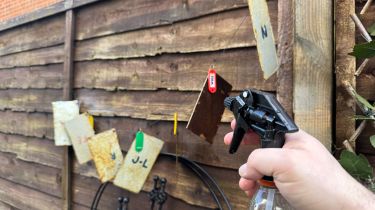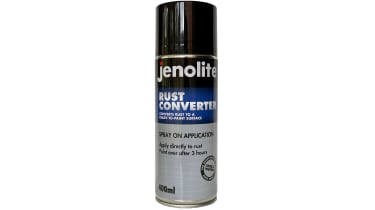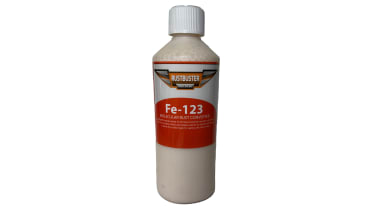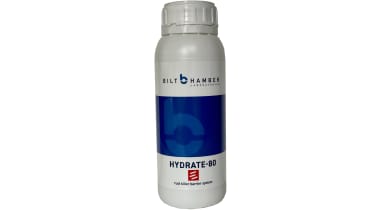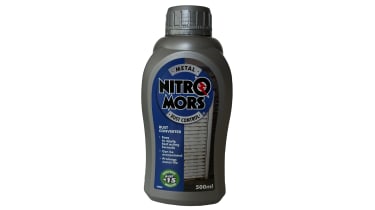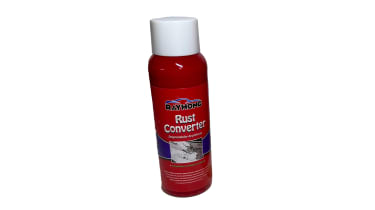Best rust converters 2024
We reveal which treatments are the most effective at keeping a cap on corrosion
Although the days of cars needing rust repairs before their first MoT are thankfully over, corrosion is still a problem that can affect any vehicle. Moisture will inevitably find its way into unprotected or thinly painted surfaces, and any salt from winter grit-spreading or sea air will rapidly accelerate the reaction – especially on the areas of your car that don’t get regularly cleaned and are hidden underneath.
If you want to stop the rot, then you’re going to need to get busy with the potions. After cleaning and removing any flakes or dirt, the next stage is to use a spray or liquid rust converter. These chemicals react with the rusty steel, killing the corrosion and turning it into a tough shell. This should then be painted or sprayed with a protective underseal coating, which will give the steel underneath the best possible chance of long-term survival.
We tested six treatments to see which is the rust buster we’d trust.
How we tested them
We took unpainted sections of 1mm-thick mild steel and left them outside for over a year until they had developed a layer of corrosion that was ingrained, but not flaking or holed. These were then dried, before both sides were treated with the rust converters, using the method suggested by the makers’ instructions.
After they had cured, one side of the sample was left unpainted, while the other was treated to two light coats of aerosol primer and top coat. Once they were dry, the steel samples were sprayed with warm salty water once a day for five weeks to encourage any corrosion and replicate winter motoring. We rated how well each kept corrosion at bay and took cost into account.
How to tackle rust
If you – or the MoT tester – spot some rust, then don’t waste any time getting it sorted, because it’s not going to get any better. An advisory in the MoT for surface corrosion is likely to mean welding will be needed the next year unless you tackle it now.
Used - available now

2023 Vauxhall
Corsa
7,300 milesManualPetrol1.2L
Cash £13,750
2021 Peugeot
208
40,776 milesManualPetrol1.2L
Cash £11,188
2022 Kia
XCeed
35,322 milesManualPetrol1.0L
Cash £13,988
2022 Volkswagen
ID.3
14,589 milesAutomaticElectric
Cash £18,269If you are getting underneath a car, make sure you use axle stands or ramps and wear eye protection and a mask. Any areas that are holed will need welding, so don’t waste your time with treatment, but surface rust should be rubbed with a wire brush and then painted with a converter. If you are treating a rust bubble on the bodywork, you will want to remove as much of the rust as possible before treating or it will soon reappear under any filler and top coat. Undersealing and protecting your car from rust is a easy and cost-effective way of reducing corrosion in the long-run.
Reviews
Jenolite Rust Converter Spray
- Price: Around £18.00
- Size: 400ml
- Cost per 100ml: £4.50
- Rating: 5 stars
- Website: jenolite.com
Jenolite’s Rust Converter is the only product here to use an aerosol spray application. This means the waxy coating went onto our sample evenly, without the puddling and uneven distribution, which often result from using a brush.
We think the spray will be economical too, even when applying two or three coats. It could be tricky to apply to some areas, though, because you might need to mask off panels. After five weeks the surface was not completely rust-free, but this was clearly the winner. Be careful not to confuse the spray with the Jenolite liquid, though – our tests show the latter is not nearly as effective.
Rustbuster Fe-123
- Price: Around £21.00
- Size: 500ml
- Cost per 100ml: £3.50
- Rating: 4.5 stars
- Website: rust.co.uk
We’ve never tested Rustbuster’s Fe-123 before, but it made an impressive debut. It is nicely thick, with the consistency of single cream, which means it’s less likely to drip off vertical surfaces while being applied. It remains white for longer too, making it easy to see which parts have been treated. After 30 minutes, it develops into a tough-looking black coating, which is ready to be painted after another two hours.
After weeks of being sprayed with salt in our test, a uniform layer of corrosion had started to appear on the unpainted side of the steel, but the other face held up well, with orange stains only just appearing on the edges.
Bilt-Hamber Hydrate-80
- Price: Around £17.00
- Size: 500ml
- Cost per 100ml: £3.39
- Rating: 4 stars
- Website: bilthamber.com
Hydrate-80 soaks into the rust quickly and easily, turning the corrosion black within a few seconds. At the end of our salt-spray test, the Bilt-Hamber’s performance was noticeably behind the top two in this comparison: the painted section of the sample had developed orange patches. The unpainted side was performing better, though, with areas where the coating was still managing to resist the rust.
The Hydrate-80 looks good value in this company, too, with a 500ml container priced at £16.95. But as a final request, please can we have a new design of lid for the container? The current cap became crusty and stuck fast after just one use.
Nitromors Rust Converter
- Price: Around £18.00
- Size: 500ml
- Cost per 100ml: £3.60
- Rating: 3.5 stars
- Website: nitromors.com
The Nitromors is satisfying to use because the watery liquid seems to soak quickly into the surface and start turning the corrosion black at once. It can be tricky to use on vertical panels, because it doesn’t cling like thicker rivals, but it seeps into gaps and drilled holes more readily.
The instructions say it only needs one coat too, which means the 500ml bottle will go a long way. The protective performance was only mid-ranking, though, with the silver finish starting to look shabby and just a few stubborn patches remaining rust-free on the unpainted side.
Hammerite Kurust
- Price: Around £12.60
- Size: 250ml
- Cost per 100ml: £5.03
- Rating: 2.5 stars
- Website: diy.com
Given Hammerite’s reputation for rust-beating products, we were expecting better from the Kurust, especially after it did well in our less gruelling test two years ago. But the samples don’t lie, and the Kurust took a hammering in the face of our salty spray.
We had to look closely to find any trace of protection on the unpainted side, and flipping the steel plate over showed it hadn’t done much better on the other face. Its case isn’t helped by the price, either. At £12.57 for a bottle of just 250ml, it looks poor value compared with the top rivals here.
Rayhong Rust Converter
- Price: Around £12.00
- Size: 100ml
- Cost per 100ml: £11.99
- Rating: 1 star
- Website: amazon.co.uk
There are a few identical listings on Amazon using different names, all offering a 100ml bottle of this distinctive converter for around £12. That makes it the most expensive here per 100ml. You are given a toy-sized paint brush as part of the package, but you need to apply at least two coats, allowing 20 minutes between layers.
The liquid didn’t react to our rust effectively and showed rust again within just a few days. By the end of our test, there was no sign of any protection on the unpainted metal, and the rust clearly won on the other side too.
Verdict
It’s another win for the Jenolite Rust Converter Spray, which is easy to apply, economical and offered the best protection in our gruelling salt test. Make sure you choose the spray rather than the less-effective liquid, though. Second place goes to Rustbuster’s Fe-123. It’s costly, especially once the steep P&P charges have been added, but it performed marginally better on the painted side of the sample than the third-placed Bilt-Hamber.
- Jenolite Rust Converter Spray
- Rustbuster Fe-123
- Bilt-Hamber Hydrate-80
Click here to discover how underseal and protect your car from rust in the long run...
